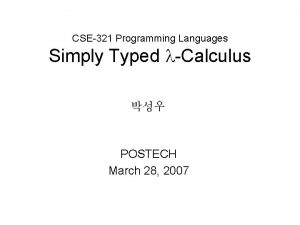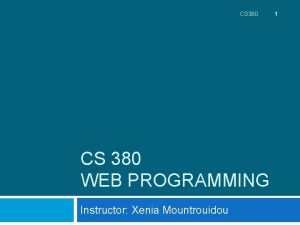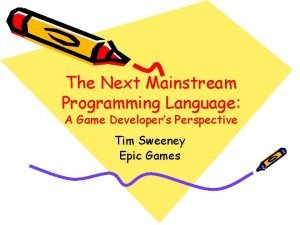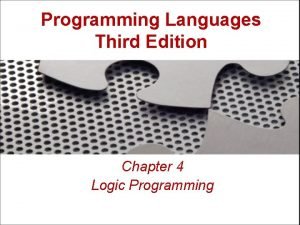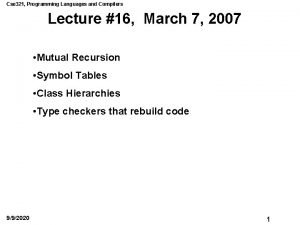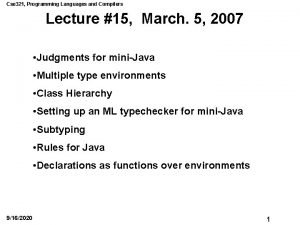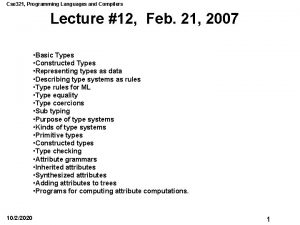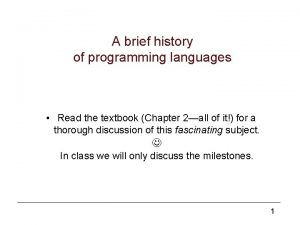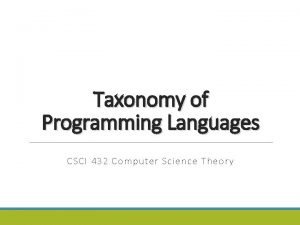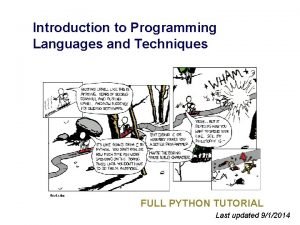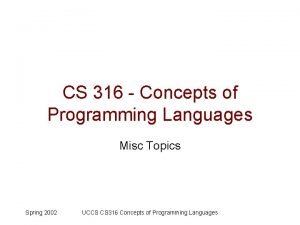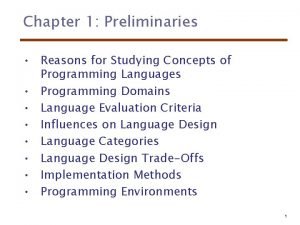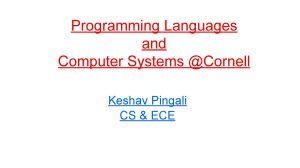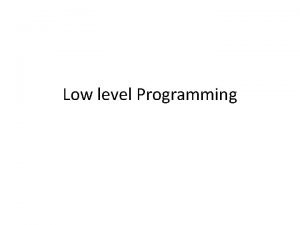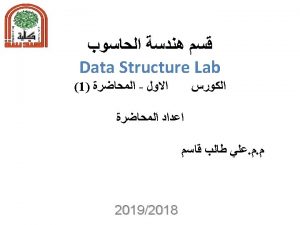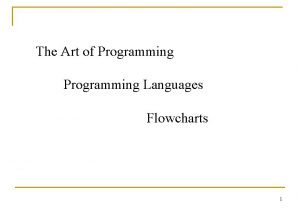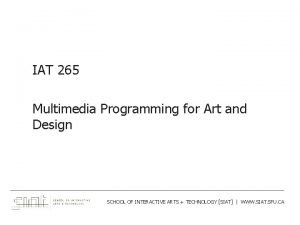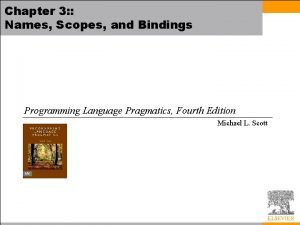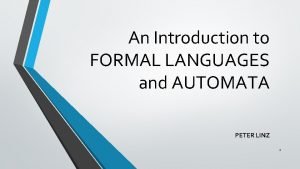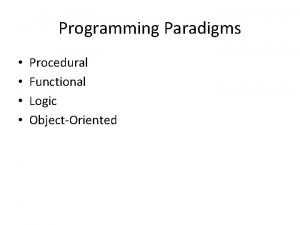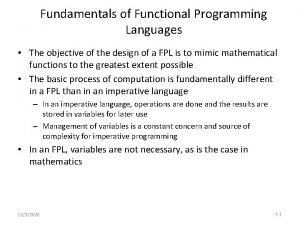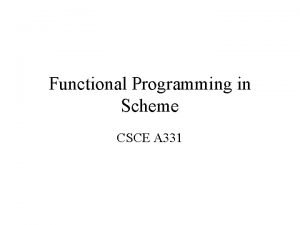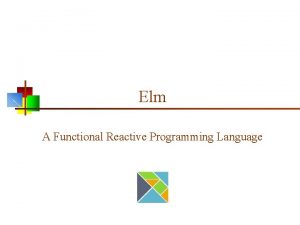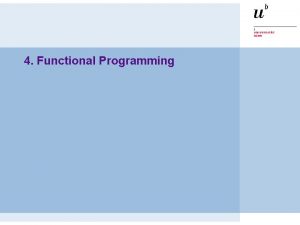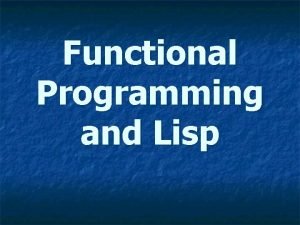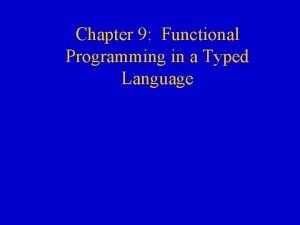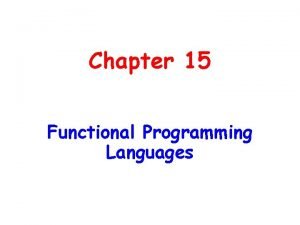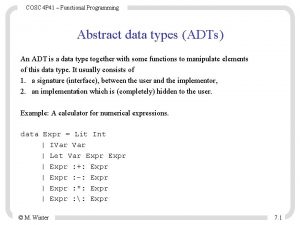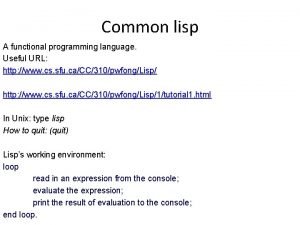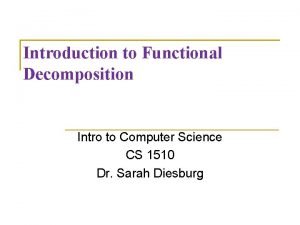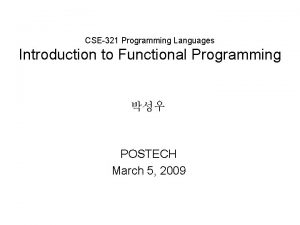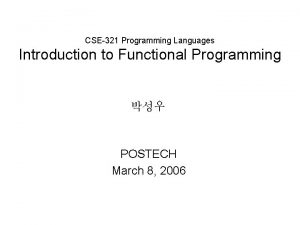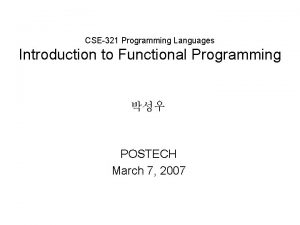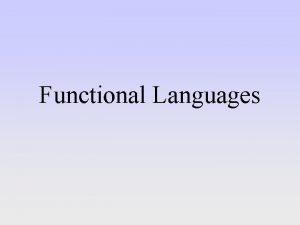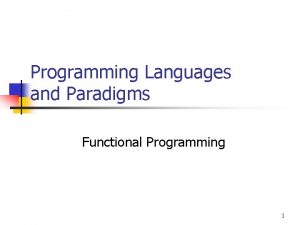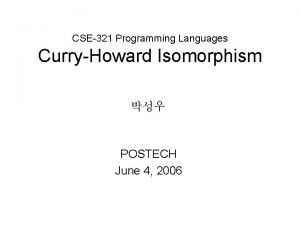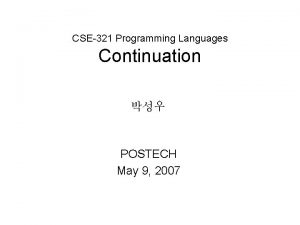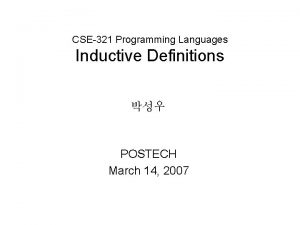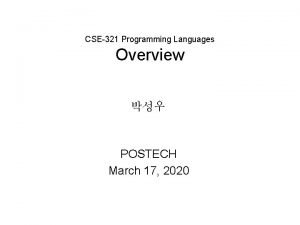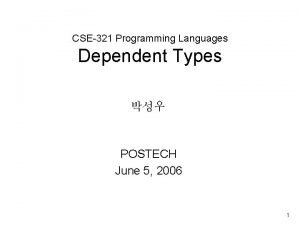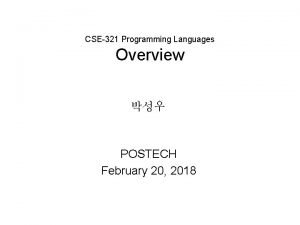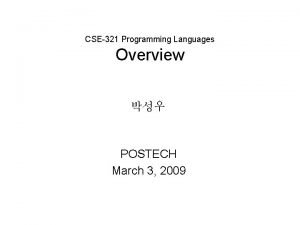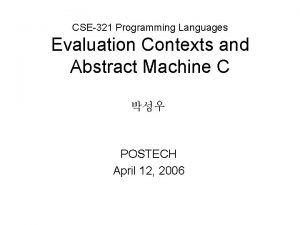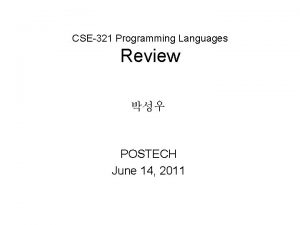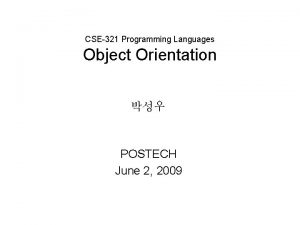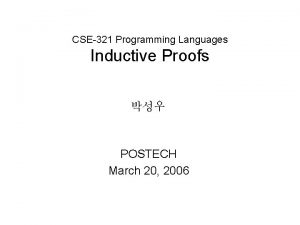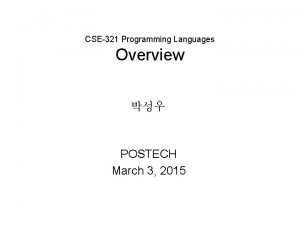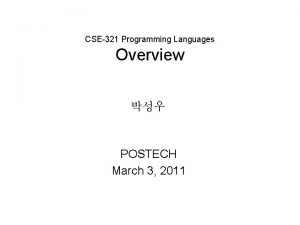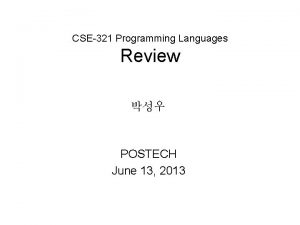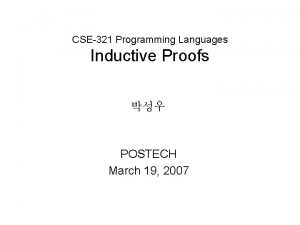CSE321 Programming Languages Introduction to Functional Programming Part




















































- Slides: 52

CSE-321 Programming Languages Introduction to Functional Programming (Part II) 박성우 POSTECH March 13, 2006

Outline • • • Expressions and values V Variables V Functions V Types – Polymorphism Recursion Datatypes Pattern matching Higher-order functions Exceptions Modules 2

What is the Type of f ? All we know about f is that it takes booleans as arguments. fn f => (f true, f false) ( f true, f false) 3

f : bool -> ? fn f => (f true, f false) : (bool -> ? ) -> ? * ? 4

f : bool -> 'a fn f => (f true, f false) : (bool -> 'a) -> 'a * 'a • 'a – type variable – usually read as alpha – means 'for any type alpha' 5

Polymorphic Types • Types involving type variables 'a, 'b, 'c, . . . • E. g. – fn x => x : 'a -> 'a – fn x => fn y => (x, y) : 'a -> 'b -> ('a * 'b) – fn (x : 'a) => fn (y : 'a) => x = y : 'a -> bool (* actually does not typecheck! *) 6

Equality Types • Motivation – Equality (=) is not defined on every type. – E. g. • comparing two functions for equality? • Type variables with equality – ''a, ''b, ''c, . . . – ''a means 'for any type alpha for which equality is defined' – fn (x : ''a) => fn (y : ''a) => x = y : ''a -> bool 7

Outline • • • Expressions and values V Variables V Functions V Types V Recursion Datatypes Pattern matching Higher-order functions Exceptions Modules 8

Recursion vs. Iteration • Recursion in SML fun sum n = if n = 0 then 0 else sum (n - 1) + n • Iteration in C int i, sum; for (i = 0, sum = 0; i <= n; i++) sum += n; • Recursion is not an awkward tool if you are used to functional programming. • Recursion seems elegant but inefficient! 9

Recursion in Action fun sum n = if n = 0 then 0 else sum (n - 1) + n call stack 0 f 1 f 9 f 10 further computation 1 + 2. . . f 8 0 + 1 36 + 9 45 + 10 55 evaluation 10

Funny Recursion fun zero n = if n = 0 then 0 else zero (n - 1) call stack 0 f 1 f 9 f 10 no further computation 0. . . f 8 0 0 evaluation 11

Funny Recursion Optimized fun zero n = if n = 0 then 0 else zero (n - 1) call stack 0 f 1 f 9 f 10 0. . . f 8 0 0 evaluation 12

Funny Recursion Further Optimized fun zero n = if n = 0 then 0 else zero (n - 1) call stack f 10 f 9 f 8 . . . f 1 f 0 0 evaluation 13

Tail Recursive Function • A tail recursive function f: – A recursive call to f is the last step in evaluating the function body. – That is, no more computation remains after calling f itself. • A tail recursive call needs no stack! • A tail recursive call is as efficient as iteration! 14

Example • Non-tail recursive sum fun sum n = if n = 0 then 0 else sum (n - 1) + n • Tail recursive sum fun sum' accum k = if k = 0 then accum else sum' (accum + k) (k - 1) fun sum n = sum' 0 n • Think about the invariant of sum: – given: sum' accum k – invariant: accum = (k + 1) +. . . + n 15

Mathematics vs. Computer Science • CS ½ Math? Math CS • CS Math? Math CS 16

Factorial Function fac 1 = 1 fac n = n * fac (n - 1) • Makes sense in – Math – CS fac 1 = 1 fac n = fac (n + 1) / n • Makes sense in math. • But not in CS: – it always diverges. • "Then what kind of recursive functions are computationally meaningful? " ) domain theory in computer science • Other examples – real numbers vs. computable real numbers – logic in math vs. logic in computer science 17

Outline • • • Expressions and values V Variables V Functions V Types V Recursion V Datatypes Pattern matching Higher-order functions Exceptions Modules 18

Enumeration Types in C enum shape { Circle, Rectangle, Triangle}; • Great flexibility – e. g. Circle + 1 == Rectangle Triangle - 1 == Rectangle (Circle + Triangle) / 2 == Rectangle • But is this good or bad? 19

Datatypes in SML datatype shape = Circle | Rectangle | Triangle • No flexibility – e. g. Circle + 1 Triangle - 1 Circle + Triangle (x) (x) • But high safety. 20

Primitive Set datatype set = Empty | Singleton | Pair | Many - Empty; val it = Empty : set - Many; val it = Many : set 21

Primitive Set with Arguments datatype set = Empty | Singleton | Pair | Many of int - Many 5; val it = Many 5 : set 22

Primitive Set with Type Parameters datatype 'a set = Empty | Singleton of 'a | Pair of 'a * 'a | Many of int - Singleton 0; val it = Singleton 0 : int set - Pair (0, 1); val it = Pair (0, 1) : int set 23

Primitive Set with Type Parameters datatype 'a set = Empty | Singleton of 'a | Pair of 'a * 'a | Many of int - Pair (Singleton 0, Pair (0, 1)) val it = Pair (Singleton 0, Pair (0, 1)) : int set 24

Primitive Set with Type Parameters datatype 'a set = Empty | Singleton of 'a | Pair of 'a * 'a | Many of int - Empty; val it = Empty : 'a set - Many 5; val it = Many 5 : 'a set 25

Primitive Set with Type Parameters datatype 'a set = Empty | Singleton of 'a | Pair of 'a * 'a | Many of int - Pair (0, true); std. In: 27. 1 -27. 15 Error: operator and operand don't agree [literal] operator domain: int * int operand: int * bool in expression: Pair (0, true) 26

Recursive Set with Type Parameters datatype 'a set = Empty | Non. Empty of 'a * 'a set • This is essentially the definition of datatype list. 27

Datatype list datatype 'a list = nil | : : of 'a * 'a list - nil; val it = [] : 'a list - 2 : : nil; val it = [2] : int list - 1 : : (2 : : nil); val it = [1, 2] : int list - 1 : : 2 : : nil; val it = [1, 2] : int list 28

Datatype list datatype 'a list = nil | : : of 'a * 'a list (X) - 1 : : [2] : : nil; (X) - [1] : : 2 : : nil; - [1] : : [2] : : nil; val it = [[1], [2]] : int list - [1] : : [[2]]; val it = [[1], [2]] : int list 29

Using Datatypes • We know how to create values of various datatypes: – shape – set – int list –. . . • But how do we use them in programming? • What is the point of creating datatype values that are never used? 30

Outline • • • Expressions and values V Variables V Functions V Types V Recursion V Datatypes V Pattern matching Higher-order functions Exceptions Modules 31

Simple Pattern datatype shape = Circle | Rectangle | Triangle (* convert. To. Enum : shape -> int *) fun convert. To. Enum (x : shape) : int = case x of Circle => 0 | Rectangle => 1 | Triangle => 2 32

Pattern with Arguments datatype 'a set = Empty | Singleton of 'a | Pair of 'a * 'a | Many of int fun size (x : 'a set) : int = case x of Empty => 0 | Singleton e => 1 | Pair (e 1, e 2) => 2 | Many n => n 33

Wildcard Pattern _ : "don't care" datatype 'a set = Empty | Singleton of 'a | Pair of 'a * 'a | Many of int fun is. Empty (x : 'a set) : bool = case x of Empty => true | _ => false 34

Pattern with Type Annotation datatype 'a list = nil | : : of 'a * 'a list fun length (x : 'a list) : int = case x of (nil : 'a list) => 0 | (_ : 'a) : : (tail : 'a list) => 1 + length tail 35

Outline • • • Expressions and values V Variables V Functions V Types V Recursion V Datatypes V Pattern matching V Higher-order functions Exceptions Modules 36

Higher-order Functions • Take functions as arguments. • Return functions as the result. 37

Why "Higher-order"? • • • T 0 T 1 T 2 T 3. . . : : = int | T 0 -> T 1 -> T 2 -> bool T 0 | T 1 | T 2 | | real T 0 T 1 T 2 | (* (* (* unit |. . . 1 st order *) 2 nd order *) higher order *) 38

Higher-order Functions in List • • • val val val exists : ('a -> bool) -> 'a list -> bool all : ('a -> bool) -> 'a list -> bool map : ('a -> 'b) -> 'a list -> 'b list filter : ('a -> bool) -> 'a list app : ('a -> unit) -> 'a list -> unit (* print. Int : int -> unit *) fun print. Int i = Text. IO. print ((Int. to. String i) ^ "n" ); List. app print. Int [1, 2, 3]; 39

List Fold Function • foldl : ('a * 'b -> 'b) -> 'b -> 'a list -> 'b foldr : ('a * 'b -> 'b) -> 'b -> 'a list -> 'b • foldl f b 0 [a 0, a 1, a 2, . . . , an-1] a 0 a 1 b 0 f b 1 f a 2 . . . an-2 b 2 f b 3. . . bn-2 f an-1 bn-1 f bn 40

Examples List. exists f l = List. foldl (fn (a, b) => b orelse f a) false l List. all f l = List. foldl (fn (a, b) => b andalso f a) true l List. app f l = List. foldl (fn (a, _) => f a) () l List. map f l = List. foldr (fn (a, b) => f a : : b) nil l List. filter f l = List. foldr (fn (a, b) => if f a then a : : b else b) nil l 41

More Examples fun sum (l : int list) = List. foldl (fn (a, accum) => a + accum) 0 l fun reverse (l : 'a list) = List. foldl (fn (a, rev) => a : : rev) nil l • Whenever you need iterations over lists, first consider foldl and foldr. 42

Outline • • • Expressions and values V Variables V Functions V Types V Recursion V Datatypes V Pattern matching V Higher-order functions V Exceptions – exception: please see the course notes. • Modules 43

Outline • • • Expressions and values V Variables V Functions V Types V Recursion V Datatypes V Pattern matching V Higher-order functions V Exceptions V Modules 44

Structures and Signatures • Structure – collection of type declarations, exceptions, values, and so on. • Signature – conceptually type of structures. structure Set = struct type 'a set = 'a list val empty. Set = nil fun singleton x = [x] fun union s 1 s 2 = s 1 @ s 2 end signature SET = sig type 'a set val empty. Set : 'a set val singleton : 'a -> 'a set val union : 'a set -> 'a set end 45

Structures + Signatures • Transparent constraint – Type definition is exported to the outside. • Opaque constraint – No type definition is exported. structure Set : SET = struct type 'a set = 'a list val empty. Set = nil fun singleton x = [x] fun union s 1 s 2 = s 1 @ s 2 end structure Set : > SET = struct type 'a set = 'a list val empty. Set = nil fun singleton x = [x] fun union s 1 s 2 = s 1 @ s 2 end - Set. singleton 1 = [1]; val it = true : bool - Set. singleton 1 = [1]; (* Error! *) 46

I need to test your 57 structures! structure. . . structure Bet. One : > HW_ONE =. . . Bigh 2000 One : > HW_ONE =. . . Boong. One : > HW_ONE = Brandon. One : > HW_ONE =. . . Ziedrich. One : > HW_ONE =. . . • How can I test 57 structures? – They all conform to the same signature. 47

Simple (but Ugly) Solution fun sum. Test f = f nil = 0 andalso f [1, 2, 3] = 6 fun fac. Test f = f 1 = 1 andalso f 3 = 6 andalso f 7 = 5040. . . fun all. Test (sum, fac, . . . ) = let val sum. Score = if sum. Test sum then 10 else 0 val fac. Score = if fac. Test fac then 4 else 0. . . in sum. Score + fac. Score +. . . end all. Test. . . all. Test (Bet. One. sum, Bet. One. fac, . . . ); (Bigh 2000 One. sum, Bigh 2000 One. fac, . . . ); (Boong. One. sum, Boong. One. fac, . . . ); (Brandon. One. sum, Brandon. One. fac, . . . ); (Ziedrich. One. sum, Ziedrich. One. fac, . . . ); 48

Functors • Functions on structures – takes a structure as an argument – returns a structure as the result structure 49

HW 1 Test Functor signature HW_TEST = sig val score : int end functor Hw 1 Test. Fn (P : HW_ONE) : HW_TEST = structure S = Hw 1 Solution val sum. Score = if P. sum nil = S. sum nil andalso P. sum [1, 2, 3] = S. sum [1, 2, 3] then 10 else 0 val fac. Score = if P. fac 1 = S. fac 1 andalso P. fac 3 = S. fac 3 andalso P. fac 7 = S. fac 7 then 4 else 0. . . val score = sum. Score + fac. Score +. . . end 50

HW 1 Test Functor in Action structure. . . structure Bet. One. Test = Hw 1 Test. Fn (Bet. One) Bigh 2000 One. Test = Hw 1 Test. Fn (Bigh 2000 One) Boong. One. Test = Hw 1 Test. Fn (Boong. One) Brandon. One. Test = Hw 1 Test. Fn (Brandon. One) Ziedrich. One. Test = Hw 1 Test. Fn (Ziedrich. One) Bet. One. Test. score; Bigh 2000 One. Test. score; Boong. One. Test. score; Brandon. One. Test. score; . . . Ziedrich. One. Test. score; 51

So it is YOU who will grade your homework! 52
 Cse321
Cse321 Introduction to programming languages
Introduction to programming languages Real-time systems and programming languages
Real-time systems and programming languages Cs 421 programming languages and compilers
Cs 421 programming languages and compilers Multithreading program in java
Multithreading program in java Programming languages levels
Programming languages levels Plc programming languages
Plc programming languages Procedural programming languages
Procedural programming languages Comparative programming languages
Comparative programming languages Alternative programming languages
Alternative programming languages Strongly typed vs weakly typed
Strongly typed vs weakly typed Transmission programming languages
Transmission programming languages Adam doupe cse 340
Adam doupe cse 340 Integral data type is
Integral data type is Xenia programming languages
Xenia programming languages Advantages and disadvantages of programming languages
Advantages and disadvantages of programming languages Mainstream programming languages
Mainstream programming languages Vineeth kashyap
Vineeth kashyap Programing languages
Programing languages Programming languages
Programming languages Programming languages
Programming languages Programming languages
Programming languages Language
Language Brief history of programming languages
Brief history of programming languages Lisp_q
Lisp_q Real-time systems and programming languages
Real-time systems and programming languages Eniac
Eniac If programming languages were cars
If programming languages were cars Reasons for studying concepts of programming languages
Reasons for studying concepts of programming languages Cornell programming languages
Cornell programming languages Low level programming languages
Low level programming languages Middle level programming languages
Middle level programming languages Programming languages flowchart
Programming languages flowchart Cs 421 programming languages and compilers
Cs 421 programming languages and compilers Iat 265
Iat 265 Storage management in programming languages
Storage management in programming languages Cantilever type space maintainer
Cantilever type space maintainer Non functional plasma enzyme example
Non functional plasma enzyme example Enzymes of blood plasma
Enzymes of blood plasma Functional and non functional
Functional and non functional Language
Language Nondeterministic means choice of moves for automata *
Nondeterministic means choice of moves for automata * Procedural vs functional
Procedural vs functional Fundamentals of functional programming
Fundamentals of functional programming Functional programming scheme
Functional programming scheme Elm lang
Elm lang Functional programming roadmap
Functional programming roadmap Lisp functional programming
Lisp functional programming Typed functional programming
Typed functional programming Fundamentals of functional programming language
Fundamentals of functional programming language Adt functional programming
Adt functional programming Is lisp a functional programming language
Is lisp a functional programming language Functional decomposition programming
Functional decomposition programming
